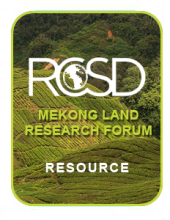Land Library
Welcome to the Land Portal Library. Explore our vast collection of open-access resources (over 74,000) including reports, journal articles, research papers, peer-reviewed publications, legal documents, videos and much more.
/ library resources
Showing items 1954 through 1962 of 1999.This paper argues that conflicts in the northern Thai highlands are a clear case of the politics of environmental discourse in the sense that conservation has played a role in lending legitimacy to both government agencies and ethnic communities in their struggle for the control of forest resourc
ABSTRACTED FROM INTRODUCTION: In this article, we aim to outline the emergence of territoriality in state power in Thailand, formerly called Siam.
ABSTRACTED FROM THE INTRODUCTION: This paper addresses the question of land rights and forest conservation for those on the periphery, i.e. the minority hill-dwelling population, specifically, the Karen.
ABSTRACTED FROM IIED WEBSITE INTRODUCTION: One of the outputs of a research project considering shifting cultivation in Thailand, Lao PDR and Vietnam.
This article explores the nature of property rights systems, their evolution, and their effect on resource allocation. It is argued that certain institutional arrangements for land rights have evolved in order to reduce uncertainty and increase efficiency in credit as well as in land markets.
The establishment or upgrading of cadastres and land registration systems is viewed by many as an essential infrastructure investment to be considered by less developed countries.
Inclusive businesses (IBs), embodying partnerships between commercial agribusinesses and smallholder farmers/low-income communities, are considered to contribute towards rural development and agricultural sector transformation.
Recently, droughts have become widespread in the Northern Hemisphere, including in Mongolia. The ground surface condition, particularly vegetation coverage, affects the occurrence of dust storms.
The concept of landscape has been increasingly used, in the last decades, in policy and land use planning, both in regard to so-called “special” and to “ordinary” or “everyday” landscapes.


